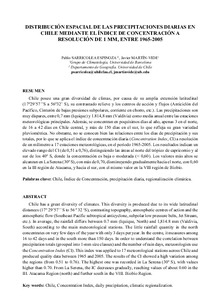Por favor, use este identificador para citar o enlazar este ítem:
http://hdl.handle.net/20.500.11765/8327
Distribución espacial de las precipitaciones diarias en Chile mediante el índice de concentración a resolución de 1 mm, entre 1965-2005
| Título : | Distribución espacial de las precipitaciones diarias en Chile mediante el índice de concentración a resolución de 1 mm, entre 1965-2005 |
| Autor : | Sarricolea, Pablo; Martín-Vide, Javier |
| Palabras clave : | Índice de concentración; Precipitación diaria; Regionalización climática; Concentration Index; Daily precipitation; Climatic regionalization |
| Fecha de publicación : | 2012 |
| Editor: | Asociación Española de Climatología |
| Citación : | Rodríguez Puebla, Concepción; Ceballos Barbancho, Antonio; González Reviriego, Nube; Morán Tejeda, Enrique; Hernández Encinas, Ascensión (eds.). Cambio climático. Extremos e impactos. Madrid: Asociación Española de Climatología, 2012, p. 631-639 |
| Resumen : | [ES]Chile posee una gran diversidad de climas, por causa de su amplia extensión latitudinal
(17º29’57’’S a 56º32’ S), su contrastado relieve y los centros de acción y flujos (Anticiclón del
Pacífico, Cinturón de bajas presiones subpolares, corriente en chorro, etc.). Las precipitaciones son
muy dispares, entre 0,7 mm (Iquique) y 1.814,8 mm (Valdivia) como media anual entre las estaciones
meteorológicas principales. Además, se concentran en poquísimos días al año, apenas 3 en el norte,
de 16 a 42 días en Chile central, y más de 150 días en el sur, lo que refleja su gran variedad
pluviométrica. No obstante, no se conocen bien las relaciones entre los días de precipitación y sus
totales, por lo que se aplica el índice de concentración diaria (Concentration Index, CI) a resolución
de un milímetro a 17 estaciones meteorológicas, en el período 1965-2005. Los resultados indican un
elevado rango del CI (de 0,51 a 0,76), distinguiendo las áreas al norte del trópico de capricornio y al
sur de los 40º S, donde la concentración es baja o moderada (< 0,60). Los valores más altos se
alcanzan en La Serena (30º S), con más de 0,70, disminuyendo gradualmente hacia el norte, con 0,60
en la III región de Atacama, y hacia el sur, con el mismo valor en la VIII región de Biobío. [EN]Chile has a great diversity of climates. This diversity is produced due to its wide latitudinal distances (17° 29’57’’ S to 56 º 32 ‘S), contrasting topography, atmospheric centres of action and the atmospheric flow (Southeast Pacific subtropical anticyclone, subpolar low pressure belts, Jet Stream, etc.). In average, the rainfall differs between 0.7 mm (Iquique, North) and 1,814.8 mm (Valdivia, South) according to the main meteorological stations. The little rainfall quantity in the north concentrates on very few days of the year with only 3 days per year. In the centre, it measures among 16 to 42 days and in the south more than 150 days. In order to understand the correlation between precipitation totals (grouped into 1-mm size classes) and the number of rain days, meteorologists use the Concentration Index (CI). This index was applied to 17 meteorological stations across Chile and produced quality data between 1965 and 2005. The results of the CI showed a high variation among the regions (from 0.51 to 0.76). The highest one was recorded in La Serena (30º S), with values higher than 0.70. From La Serena, the IC decreases gradually, reaching values of about 0.60 in the III. Atacama Region (north) and further south in the VIII. Biobío Region. |
| Descripción : | Ponencia presentada en: VIII Congreso de la Asociación Española de Climatología celebrado en Salamanca entre el 25 y el 28 de septiembre de 2012. |
| Patrocinador: | El trabajo se inserta también en el proyecto CGL2011-29263-C02-01 (Ministerio de Economía y Competitividad, España) y en el marco del Grupo de Climatología 2009 SGR 443 (Generalitat de Catalunya). |
| URI : | http://hdl.handle.net/20.500.11765/8327 |
| ISBN : | 978-84-695-4331-3 |
| Colecciones: | (2012, Salamanca). VIII Congreso AEC |
Ficheros en este ítem:
| Fichero | Descripción | Tamaño | Formato | ||
|---|---|---|---|---|---|
| 0061_VIII-2012-P_SARR... | 4,05 MB | Adobe PDF |  Visualizar/Abrir |
Los ítems de Arcimis están protegidos por una Licencia Creative Commons, salvo que se indique lo contrario.





